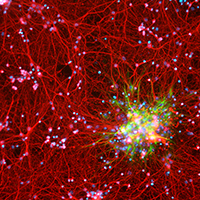Quantitative, structural and molecular changes in neuroglia of aging mammals: A review

Accepted: 27 May 2021
HTML: 11
All claims expressed in this article are solely those of the authors and do not necessarily represent those of their affiliated organizations, or those of the publisher, the editors and the reviewers. Any product that may be evaluated in this article or claim that may be made by its manufacturer is not guaranteed or endorsed by the publisher.
Authors
The neuroglia of the central and peripheral nervous systems undergo numerous changes during normal aging. Astrocytes become hypertrophic and accumulate intermediate filaments. Oligodendrocytes and Schwann cells undergo alterations that are often accompanied by degenerative changes to the myelin sheath. In microglia, proliferation in response to injury, motility of cell processes, ability to migrate to sites of neural injury, and phagocytic and autophagic capabilities are reduced. In sensory ganglia, the number and extent of gaps between perineuronal satellite cells – that leave the surfaces of sensory ganglion neurons directly exposed to basal lamina– increase significantly. The molecular profiles of neuroglia also change in old age, which, in view of the interactions between neurons and neuroglia, have negative consequences for important physiological processes in the nervous system. Since neuroglia actively participate in numerous nervous system processes, it is likely that not only neurons but also neuroglia will prove to be useful targets for interventions to prevent, reverse or slow the behavioral changes and cognitive decline that often accompany senescence.
How to Cite
PAGEPress has chosen to apply the Creative Commons Attribution NonCommercial 4.0 International License (CC BY-NC 4.0) to all manuscripts to be published.
Similar Articles
- S. Iachettini, R. Valaperta, A. Marchesi, A. Perfetti, G. Cuomo, B. Fossati, L. Vaienti, E. Costa, G. Meola, R. Cardani, Tibialis anterior muscle needle biopsy and sensitive biomolecular methods: a useful tool in myotonic dystrophy type 1 , European Journal of Histochemistry: Vol. 59 No. 4 (2015)
- P de Girolamo, C Costagliola, C Lucini, G Gargiulo, L Castaldo, The autonomous innervation of the buffalo (Bubalus bubalis) testis. An immunohistochemical study , European Journal of Histochemistry: Vol. 47 No. 2 (2003)
- PA Possik, CA Sommer, J Issa Hori, GM Machado-Santelli, MC Jamur, F Henrique-Silva, DSCR2, a Down syndrome critical region protein, is localized to the endoplasmic reticulum of mammalian cells , European Journal of Histochemistry: Vol. 48 No. 3 (2004)
- L Vecchio, B Cisterna, M Malatesta, TE Martin, M Biggiogera, Ultrastructural analysis of testes from mice fed on genetically modified soybean , European Journal of Histochemistry: Vol. 48 No. 4 (2004)
- Li Wu, Dan Han, Jie Jiang, Xiaojie Xie, Xunran Zhao, Tengfei Ke, Wen Zhao, Liu Liu, Wei Zhao, Co-transplantation of bone marrow mesenchymal stem cells and monocytes in the brain stem to repair the facial nerve axotomy , European Journal of Histochemistry: Vol. 64 No. s2 (2020): Special Collection on Stem Cells and Regenerative Medicine
- F Cappello, A Ribbene, C Campanella, AM Czarnecka, R Anzalone, F Bucchieri, The value of immunohistochemical research on PCNA, p53 and heat shock proteins in prostate cancer management: a review , European Journal of Histochemistry: Vol. 50 No. 1 (2006)
- M Aita, E Carafelli, L Alfei, B Caronti, Thymic development in surgically bursectomized embryonic chicken: expression of PCNA, CD3, CD4 and CD8 markers , European Journal of Histochemistry: Vol. 51 No. 4 (2007)
- RM Ruggeri, F Ferraù, A Campennì, A Simone, V Barresi, G Giuffrè, G Tuccari, S Baldari, F Trimarchi, Immunohistochemical localization and functional characterization of somatostatin receptor subtypes in a corticotropin releasing hormonesecreting adrenal phaeochromocytoma: review of the literature and report of a case , European Journal of Histochemistry: Vol. 53 No. 1 (2009)
- S.S. Hu, L. Mei, J.Y. Chen, Z.W. Huang, H. Wu, Expression of immediate-early genes in the inferior colliculus and auditory cortex in salicylate-induced tinnitus in rat , European Journal of Histochemistry: Vol. 58 No. 1 (2014)
- OM EcheverrÃa, RV Thampan, S Juárez-Chavero, AD Hernández-Pérez, Immunocytochemical study of estrogen receptor activation factor (E-RAF) and the proteins that interact with nuclear estrogen receptor II (nER II) in epithelial endometrial cells, in the presence and in the absence of estradiol , European Journal of Histochemistry: Vol. 49 No. 1 (2005)
<< < 64 65 66 67 68 69 70 71 72 73 > >>
You may also start an advanced similarity search for this article.

 https://doi.org/10.4081/ejh.2021.3249
https://doi.org/10.4081/ejh.2021.3249










